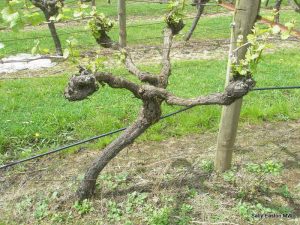Old vines – defined only in the new world?
 First published, as part of a longer piece, in the April 2015 issue of The Drinks Business.
First published, as part of a longer piece, in the April 2015 issue of The Drinks Business.
There is a real or imagined cachet for old vines. In Europe the various monikers – vieilles vignes, viñas viejas, alte reben etc. – are used solely at the quality discretion or implied marketing intention of the producer. The new world is taking a different approach.
Barossa Old Vine Charter
Australia’s Yalumba drew the first line in the sand in 2007 with their Old Vine Charter, “dedicated to the recognition, preservation and promotion” of their old vines in the Barossa. The charter was subsequently tweaked and adopted by the Barossa Grape and Wine Association, for the whole of that region.
Louisa Rose, Yalumba’s head of winemaking, explained “the concept of 35, 70 years is based around a human generational concept. Seventy is two generations of people who thought the vines were special enough to keep in the ground.”
Old 35 years plus beyond adolescence; fully rooted and mature
Survivors 70 years plus twice the age and survived the 1980s vine pull scheme
Centenarians 100 years plus thrice the age, give or take.
Ancestors 125 years plus nothing left to prove. “tend to be dry-grown, low-yielding vines of great flavour and intensity”
No wine style or quality statements are associated with the age categories.
California Historic Vineyards Society
This group formed in 2010 with the aim of preserving old vine vineyards in California. Old vines are defined as those greater than 50 years. This is the same age used by federal government to define things, such as homes, as being of historic nature.
Mike Officer of Carlisle Winery said “we felt creating a registry of all vineyards in which one-third or more of the vines are at least 50 years old would be of great interest to consumers as well as to other growers and producers.” David Gates Jr., vice president of vineyard operations at Ridge Vineyards added “a vineyard of 50 years or older has already lasted almost 3 times as long as the vast majority of California vineyards. Fifty years also represents at least two generations of people tending these vines, dedicated to preserving them and earning their livelihood, especially 30+ years ago, from them.”
Officer added “old-vine vineyards are complex ecosystems that have taken decades and decades to develop. There’s something special and unique to an old-vine wine that cannot be easily replicated.”
The society has no plans to formalise a definition of ‘old vine’ for wine marketing.
Vigno – Vignadores de carigan
A group of about dozen growers of 30+ year old, unirrigated, carignan in Chile’s Maule, created an association in 2009, with the aim, said Ricardo Baettig, the director of Vigno, “to become the first DOC of Chile.”
Wines must have a minimum of 65% carignan
Wines are sold under the name Vigno
South Africa
An audit of vines older than 35 years in South Africa is under way. Kruger said “the 35 age barrier was just an idea by some of us interested in old vines.” Sadie works with some of these old vines. He said “South Africa has the third biggest acreage of old vines (35 years) after France and Spain.”



